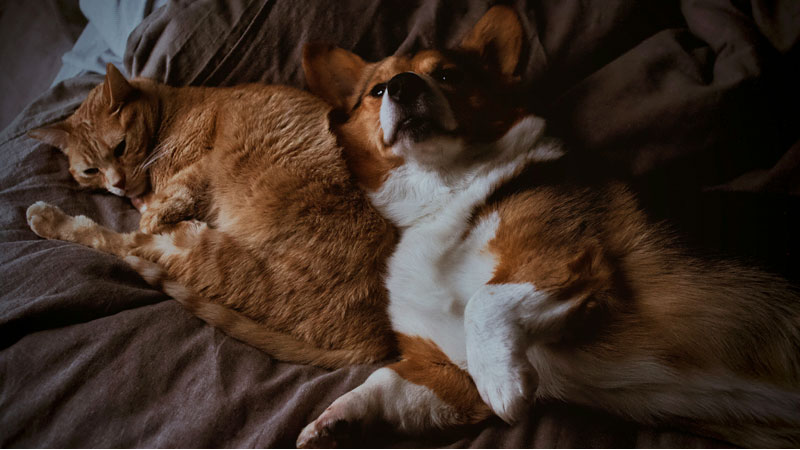Colds in Cats and Dogs: A Comprehensive Guide

Photo by Bri Tucker on Quora
As pet owners, our furry companions become an integral part of our families, providing joy, companionship, and sometimes a perplexing concern when they exhibit signs of a cold. While both cats and dogs can experience respiratory issues similar to human colds, it's crucial for pet parents to understand the nuances of colds in their four-legged friends.
In this comprehensive guide, we'll explore the causes, symptoms, preventative measures, and effective strategies to care for your beloved pets during the cold season.
Understanding Colds in Cats and Dogs
Causes and Transmission
Similar to humans, cats and dogs can suffer from colds caused by viruses or bacteria. Upper respiratory infections (URIs) are common culprits, affecting the nose, throat, and sometimes the eyes of our pets. These infections are often transmitted through contact with infected animals, contaminated environments, or shared items.
Cats, being territorial creatures, can contract cold viruses through interactions with other felines, especially in crowded spaces like shelters or boarding facilities. Dogs, with their social nature, are susceptible to picking up viruses during interactions at parks, kennels, or grooming salons. Understanding the source of transmission is vital for implementing effective preventative measures.
Signs and Symptoms
Recognizing the signs of a cold in your cat or dog is essential for prompt intervention. Common symptoms include:
Cats:
- Sneezing
- Runny nose
- Watery eyes
- Coughing
- Lethargy
- Reduced appetite
Dogs:
- Sneezing
- Coughing
- Runny nose
- Watery eyes
- Fever
- Lethargy
- Decreased activity
Differences in Manifestations
While there are similarities in the symptoms of colds in both cats and dogs, there are notable differences in how these symptoms manifest. Cats are more prone to develop ocular symptoms, such as watery eyes and squinting, while dogs commonly exhibit a persistent cough, which is less typical in feline respiratory infections.
Moreover, the causative agents for cold-like illnesses differ between the two species. Feline herpesvirus and calicivirus are predominant in cats, while dogs can be affected by a range of viruses, including parainfluenza and adenovirus.
Preventative Measures
Proactive steps can significantly reduce the risk of your pets contracting colds:
Vaccinations:
Ensure your pets are up-to-date on vaccinations. Vaccines for common respiratory viruses, such as canine influenza or feline herpesvirus, can provide a crucial layer of protection.
Hygiene Practices:
Practice good hygiene by washing your hands thoroughly after interacting with other animals, particularly in multi-pet households. Regularly clean and disinfect pet belongings, such as bowls, toys, and bedding.
Stress Management:
Stress weakens the immune system, making pets more susceptible to infections. Create a stress-free environment, especially during changes like moving homes or introducing new pets.
Regular Veterinary Check-ups:
Schedule routine check-ups with your veterinarian. Early detection of underlying health issues can prevent complications and strengthen your pet's overall immunity.
Caring for a Pet with a Cold
When your cat or dog displays symptoms of cold, compassionate care is crucial for their recovery:
Comfort and Rest:
Provide a warm and comfortable space for your pet to rest. Ensure they have access to a cozy bed and a quiet area where they can recuperate undisturbed.
Hydration and Nutrition:
Encourage your pet to stay hydrated by providing fresh water. Offer palatable and easily digestible food, which may be warmed slightly to enhance its aroma and appeal.
Humidification:
For respiratory congestion, using a humidifier can moisten the air and ease breathing difficulties. Ensure proper ventilation and avoid exposing your pet to overly dry conditions.
Veterinary Consultation:
If your pet's symptoms persist or worsen, consult your veterinarian promptly. Professional guidance is essential for determining the appropriate course of treatment, including potential medications or therapies.
When to Seek Veterinary Care
While many mild colds in pets resolve on their own, certain signs warrant immediate veterinary attention:
Persistent Symptoms: If symptoms persist for more than a week without improvement.
Severe Respiratory Distress: Difficulty breathing, open-mouthed breathing, or persistent coughing.
Lethargy and Refusal to Eat: A notable decrease in activity levels or a refusal to eat.
Prompt veterinary care ensures an accurate diagnosis and tailored treatment plan for your pet's specific condition.
Conclusion
Navigating the complexities of colds in cats and dogs requires a proactive and informed approach from pet owners. Understanding the causes, recognizing symptoms, and implementing preventative measures are key components of responsible pet care. Additionally, providing thoughtful and compassionate care when your furry friend is under the weather is essential for a swift and comfortable recovery.
By prioritizing vaccinations, maintaining good hygiene practices, managing stress, and seeking timely veterinary care, you can safeguard your pets against the challenges of the cold season.
You May Also Like
 Cat HealthWhat Is The Normal Body Temperature Of A Cat?
Cat HealthWhat Is The Normal Body Temperature Of A Cat? Cat HealthDo Cats Carry The Feline Coronavirus For Life?
Cat HealthDo Cats Carry The Feline Coronavirus For Life? Cat HealthHow To Take A Cats Temperature?
Cat HealthHow To Take A Cats Temperature? Cat BehaviorWhy Do Cats Love Running Water?
Cat BehaviorWhy Do Cats Love Running Water? Help & AdviceExploring the Debate: Is Fresh Food Better for Cats?
Help & AdviceExploring the Debate: Is Fresh Food Better for Cats? Cat BehaviorWhy Cats Adore Fresh, Nutritious Food
Cat BehaviorWhy Cats Adore Fresh, Nutritious Food